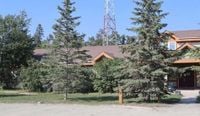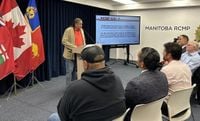On September 4, 2025, tragedy struck the Hollow Water First Nation community in Manitoba, Canada, when a mass stabbing left two people dead and at least six others wounded. The incident, which unfolded on Thursday afternoon, sent shockwaves through the tight-knit Anishinaabe (Ojibwa) community and prompted swift responses from law enforcement, Indigenous leaders, and health officials alike.
According to the Royal Canadian Mounted Police (RCMP), the violence began when 26-year-old Tyrone Simard fatally stabbed his sister and wounded several others in the community, located about two hours outside Winnipeg on the east side of Lake Winnipeg. As the news spread, a heavy police presence quickly descended on the area, and roads near the scene were closed to ensure public safety and facilitate emergency response efforts.
After the initial attack, Simard fled the scene in a stolen vehicle but did not get far. In a harrowing turn of events, he collided with a police officer who was responding to the unfolding crisis. The crash proved fatal for Simard, while the officer suffered critical injuries and was rushed to the hospital. Authorities later reported that the officer was expected to recover, though the trauma of the day’s events would linger much longer in the memories of those involved.
Details about the attack and its aftermath trickled out over the course of the day. A spokesperson for Manitoba Shared Health told CBC that eight people had been transported to hospitals with varying degrees of injury, prompting a ‘code orange’—a designation used by hospitals to indicate a mass casualty event and mobilize additional resources. The swift medical response likely saved lives, but the emotional scars for survivors and the community will be deep.
In an official statement, the RCMP acknowledged the gravity of the situation and the need for clear communication: “Our officers are gathering information to determine what exactly occurred this morning and we will be providing a more detailed update early this afternoon.” The message was intended to reassure the public that the threat had passed and that authorities were working diligently to piece together the sequence of events.
By the end of the day, police confirmed that there was no further risk to public safety. Residents, many of whom knew the victims personally, were left to grapple with the shock and grief of what had transpired. The Hollow Water First Nation, home to a vibrant Anishinaabe (Ojibwa) community, is not unfamiliar with hardship, but mass violence of this nature is almost unheard of in the region.
The timing of the attack added a layer of poignancy and unease. It occurred exactly three years after a devastating mass stabbing on the James Smith Cree Nation in Saskatchewan and the nearby community of Weldon, which left 11 people dead and 17 injured. That earlier tragedy had already cast a long shadow over Indigenous communities across Canada, raising difficult questions about violence, mental health, and the resources available to First Nations people.
Indigenous leaders and officials were quick to respond, offering condolences and support while calling for unity and reflection. The parallels between the Hollow Water and James Smith Cree Nation attacks were not lost on anyone. Both incidents have reignited discussions about the underlying social and economic challenges facing Indigenous communities—challenges that can sometimes manifest in heartbreaking ways.
Health officials, meanwhile, worked tirelessly to treat the wounded and provide support to families affected by the violence. The ‘code orange’ activation at local hospitals underscored the seriousness of the situation and the commitment of medical staff to respond swiftly and effectively. According to Manitoba Shared Health, the hospitals were able to manage the influx of patients, and all those injured received the care they needed.
In the days following the attack, community members gathered to mourn the loss of life and to support one another. Vigils and ceremonies were organized, drawing on the strength and resilience of Hollow Water First Nation’s cultural traditions. For many, these gatherings offered a way to process grief and begin the long journey toward healing.
The RCMP’s investigation into the events of September 4 is ongoing. Authorities have not yet released a detailed account of what led to the attack, but they have promised transparency as more information becomes available. The focus, for now, remains on supporting the victims and ensuring that the community has the resources it needs to recover.
While the immediate threat has passed, the reverberations of the tragedy will be felt for a long time. The mass stabbing has once again highlighted the vulnerabilities that exist in some Indigenous communities, including gaps in mental health services, the impact of intergenerational trauma, and the need for culturally informed support systems. Many local leaders have reiterated calls for increased funding and attention from provincial and federal governments to address these longstanding issues.
At the same time, the response from law enforcement and health professionals has demonstrated the importance of coordinated emergency planning and the value of community resilience. The quick action taken by police and medical staff undoubtedly prevented further loss of life and provided a measure of reassurance to residents during an unimaginably difficult time.
The story of the Hollow Water First Nation mass stabbing is, at its core, a story of loss—but also of strength and solidarity. As the community mourns and begins to heal, there is a renewed sense of urgency to address the root causes of such tragedies and to ensure that all Canadians, regardless of where they live, have access to the support and resources they need.
For now, the people of Hollow Water First Nation are leaning on one another, drawing on their shared history and cultural values to navigate the aftermath of violence. The road to healing will not be easy, but the resilience of this community—tested once again—remains unbroken.


